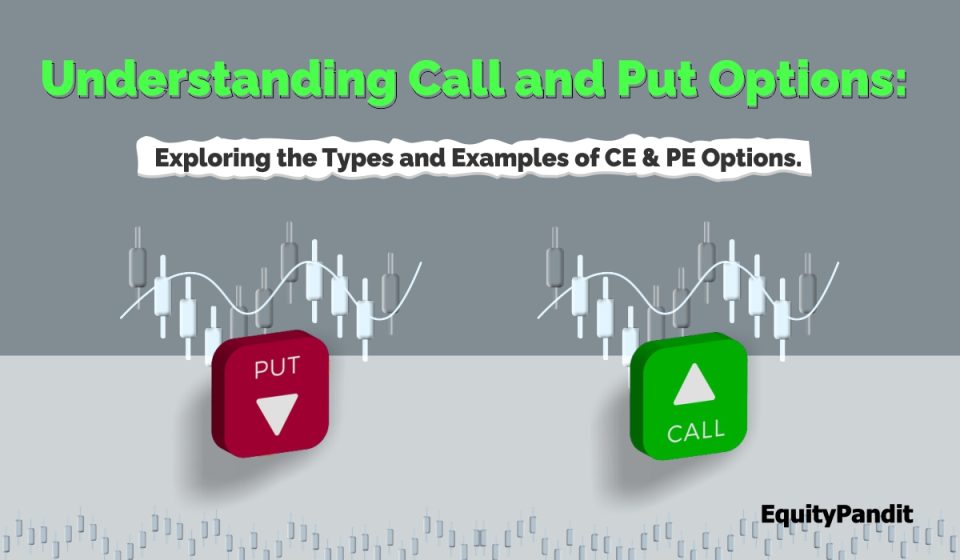Trading in Options can be tricky, you need proper guidance to trade in Options. This blog will guide you towards the conceptual understanding of different Options. Options are contracts or derivatives that give the buyer the right to buy or sell an asset at a specific price by a particular date but are not obligated to do so.
Options consist of two types: call options and put options. Call and put options can be further classified as American or European options. American options can be exercised any time before the expiration date, while European options can only be exercised on the expiration date. Call and Put Options are also known as CE & PE Options, respectively.
What is a Call Option?
A Call Option gives the right, but not the obligation to buy the shares/stocks of a company at a pre-defined price on or before the pre-determined date of the stocks.
Types of Call Option
1) Long
When an investor has a ‘long’ position, it means they have the right (but not the obligation) to purchase an asset at a predetermined price in the future. This type of option gives the buyer a sense of control, allowing them to plan for a purchase at a lower cost. Many traders use long-call options, particularly stocks with high dividend yields.
This is because stock prices often increase leading up to the ex-dividend date, after which they typically decrease. It’s important to note that long-call holders only receive dividends if they exercise the option before the specific ex-dividend date, further reinforcing their control over the situation.
2) Short
When it comes to short-call options, the seller is under obligation to sell shares at a predetermined strike price. This type of option, the opposite of a long call option, is all about potential profits. Short-call options are commonly used for covered calls, where the seller already owns the underlying asset, or for call options, where they anticipate holding the underlying asset in the future.
The profit potential associated with this type of option can be a strong motivator for traders, as it allows them to generate profits from their existing assets or from assets they intend to acquire in the future.
How do Call Options work?
Call options give investors the right to buy a specific security at a set price, but they are not obligated to do so. Each contract typically consists of 100 shares. The investor buying the call option contract must pay the option premium to the seller. Both buyers and sellers determine the value of call options based on the underlying security.
If the security’s price goes beyond the contract’s strike price, the call option will have value at expiry, allowing the holder to purchase the stock at a lower price. During expiry, the call option’s value represents a benefit to the buyer and a cost to the seller.
A real-life example of a Call Option
If ABC India’s stock is currently priced at Rs—100 per share and Investor A owns 100 shares, they may be interested in generating additional income. However, they do not expect the stock price to rise above Rs—150 in the next month.
Investor A explores call options and finds a call trading at Rs. 150, with each contract priced at 50p. A decides to sell one call option and receives Rs. 50 as the premium amount.
If the stock price exceeds Rs. 150, the option buyer will have the right to buy. In this case, A would need to sell the shares at Rs. 150 per share. However, if the price remains below Rs. 150, A can keep the shares without selling them.
What is a Put Option?
A Put Option gives the right, but not the obligation to sell the shares/stocks of a company at a pre-defined price on or before the pre-determined date of the stocks.
Types of Put Option
A put option gives the holder the right to sell a specified amount of an underlying asset at a predetermined price within a set time frame. This type of option brings significant profits when the cost of the underlying asset decreases. Two main put options are the Long Put and Short Put.
- A long put involves purchasing a put option. Investors typically take this position when they expect the underlying asset’s price to decline within a specific period. Buying the put option protects investors from potential losses that may arise from a decrease in the asset’s value.
- A short put refers to a situation where investors sell a put option, also known as writing a put. This strategy is employed when an investor believes the underlying asset will not decrease in value over a specified period. By selling a put option, the option seller can earn income if the buyer does not exercise the option by its expiration date.
The put option strategy mitigates risks and protects traders, regardless of whether they act as buyers or sellers. This form of investment insurance helps to a certain extent in hedging risks associated with the underlying securities.
How Do Put Options Work?
Put options are a way to make money if a stock goes down. If the stock price decreases, the value of the put option goes up. This can offer a potential profit. On the other hand, if the stock price goes up significantly, the value of the put option goes down. This can result in a loss.
When you buy a put option, you are betting that the stock’s value will go down. If you sell a put option, you are betting that the stock’s value will go up. Put options can be used as a way to protect against stock price decreases when you own the stock. They can also be used for speculation.
A real-life example of Put Option
When you buy a put option, you are purchasing the right to sell a specific number of shares of a stock at a set price. For example, if A buys one put option for 100 shares of Ford stock at a price of Rs.100 per share, they have the right to sell those 100 shares of Ford stock at Rs.100 per share. This right is valid until the expiration date. If A already owns 100 shares of Ford stock and wants to use the put option, their broker will sell the shares at the Rs.100 strike price, and an option writer will buy the shares at the same price to complete the transaction.
Frequently Asked Questions (FAQs)
What is a Strike Price?
The options contract’s strike price is the price at which the underlying security can be purchased or sold upon execution of the contract.
What is Spot Price?
The spot price refers to the current market price at which a particular asset, such as a stock or commodity, can be bought or sold for immediate delivery and payment.
What is Option Premium?
The option premium is the price paid by the option buyer to the seller for the right to buy or sell an underlying asset at a specified price within a certain period.
What is Options Expiry?
Options contracts typically have an expiration date on the last Thursday of the expiration month.
How is settlement made in India for Option Contracts?
In India, cash is used for settling options contracts.
What is the Pay-off for Call Option Buyers and Sellers?
The pay-off is the Spot Price minus the Strike Price.
What is the profit for Call Option Buyers?
Profit is Payoff minus Premium paid.
What is the profit for Call Option Sellers?
Profit is Payoff plus Premium paid.
If you are looking to trade in F&O Stocks but don’t want to spend too much time doing research, check out Unicorn Signals, The Super App for Indian Stock Market.
Explore the Unicorn Signals App, and you will come across Stock Futures Intraday Scans and Live Options Scans, where you can find the right stocks and signals to trade effectively in the F&O segment.
Disclaimer: Trading in the F&O segment in India is subject to risks. This article is purely for educational purposes. The information provided here is by Equitypandit’s team and is for educational purposes. Kindly do not completely depend on the information provided as the risk appetite differs from individual to individual and there are various other factors in the market to determine the factors to invest in the market.







